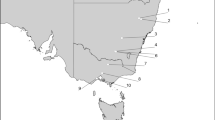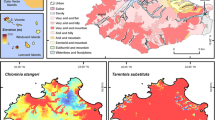Abstract
Phenotypic plasticity can contribute to the process of adaptive radiation by facilitating population persistence in novel environments. West Indian Anolis lizards provide a classic example of an adaptive radiation, in which divergence has occurred along two primary ecological axes: structural microhabitat and climate. Adaptive plasticity in limb morphology is hypothesized to have facilitated divergence along the structural niche axis in Anolis, but very little work has explored plasticity in physiological traits. Here, we experimentally ask whether Puerto Rican Anolis cristatellus from mesic and xeric habitats differ in desiccation rates, and whether these lizards exhibit an acclimation response to changes in relative humidity. We first present microclimatic data collected at lizard perch sites that demonstrate that abiotic conditions experienced by lizards differ between mesic and xeric habitat types. In Experiment 1, we measured desiccation rates of lizards from both habitats maintained under identical laboratory conditions. This experiment demonstrated that desiccation rates differ between populations; xeric lizards lose water more slowly than mesic lizards. In Experiment 2, lizards from each habitat were either maintained under the conditions of Experiment 1, or under extremely low relative humidity. Desiccation rates did not differ between lizards from the same habitat maintained under different treatments and xeric lizards maintained lower desiccation rates than mesic lizards within each treatment. Our results demonstrate that A. cristatellus does not exhibit an acclimation response to abrupt changes of hydric conditions, and suggest that tropical Anolis lizards might be unable to exhibit physiological plasticity in desiccation rates in response to varying climatic conditions.
Similar content being viewed by others
References
Agrawal AA (2001) Phenotypic plasticity in the interactions and evolution of species. Science 294:321–326
Bentley PJ, Schmidt-Nielsen K (1966) Cutaneous water loss in reptiles. Science 151:1547–1549
Calsbeek R, Knouft JH, Smith TB (2006) Variation in scale numbers is consistent with ecologically based natural selection acting within and between lizard species. Evol Ecol 20:377–394
Daly C, Helmer EH, Quiñones M (2003) Mapping the climate of Puerto Rico, Vieques and Culebra. Int J Climatol 23:1359–1381
DeWitt TJ, Sih A, Wilson DS (1998) Costs and limits of phenotypic plasticity. Trends Ecol Evol 13:77–81
Dmi’el R, Perry G, Lazell J (1997) Evaporative water loss in nine insular populations of the lizard Anolis cristatellus group in the British Virgin Islands. Biotropica 29:111–116
Ewel JJ, Whitmore JL (1973) The ecological life zones of Puerto Rico and the U.S. Virgin Islands. Forest Service Research Paper ITF-18
Eynan M, Dmi’el R (1993) Skin resistance to water loss in agamid lizards. Oecologia 95:290–294
Ghalambour CK, McKay JM, Carroll SP, Reznick DN (2007) Adaptive versus non-adaptive phenotypic plasticity and the potential for contemporary adaptation in new environments. Funct Ecol 21:394–407
Heatwole H (1976) Herpetogeography of Puerto Rico VII. Geographic variation in the Anolis cristatellus complex in Puerto Rico and the Virgin Islands. Occas Pap Mus Nat Hist Univ Kansas 46:1–18
Helmer EH, Ramos O, López TDM, Quiñones M, Diaz W (2002) Mapping the forest type and land cover of Puerto Rico, a component of the Caribbean biodiversity hotspot. Carib J Sci 38:165–183
Hertz PE (1979) Sensitivity to high temperatures in three West Indian grass anoles (Sauria, Iguanidae), with a review of heat sensitivity in the genus Anolis. Comp Biochem Physiol 63:217–222
Hertz PE (1980) Responses to dehydration in Anolis lizards sampled along altitudinal transects. Copeia 1980:440–446
Hertz PE (1992a) Temperature regulation in Puerto Rican Anolis lizards: a field test using null hypotheses. Ecology 73:1405–1417
Hertz PE (1992b) Evaluating thermal resource partitioning by sympatric lizards Anolis cooki and A cristatellus: a field test using null hypotheses. Oecologia 90:127–136
Hertz PE, Arce-Hernandez A, Ramirez-Vasquez J, Tirado-Rivera W, Vazquez-Vives L (1979) Geographical variation of heat sensitivity and water loss rates in the tropical lizard, Anolis gundlachi. Comp Biochem Physiol 62:947–953
Hertz PE, Huey RB, Stevenson RD (1993) Evaluating temperature regulation by field-active ectotherms: the fallacy of the inappropriate question. Am Nat 142:796–818
Hillman SS, Gorman GC (1977) Water loss, desiccation tolerance, and survival under desiccating conditions in 11 species of Caribbean Anolis evolutionary and ecological implications. Oecologia 29:105–116
Hillman S, Gorman GC, Thomas R (1979) Water loss in Anolis lizards: evidence for acclimation and intraspecific differences along a habitat gradient. Comp Biochem Physiol 62:491–494
Huey RB, Webster TP (1976) Thermal biology of Anolis lizards in a complex fauna: the cristatellus group on Puerto Rico. Ecology 57:985–994
Kattan GH, Lillywhite HB (1989) Humidity acclimation and skin permeability in the lizard Anolis carolinensis. Physiol Zool 62:593–606
Kobayashi D, Mautz WJ, Nagy KA (1983) Evaporative water loss: humidity acclimation in Anolis carolinensis lizards. Copeia 1983:701–704
Kolbe JJ, Losos JB (2005) Hind-limb length plasticity in Anolis carolinensis. J Herpetol 39:674–678
Lillywhite HB (2006) Water relations of tetrapod integument. J Exp Biol 209:202–226
Lillywhite HB, Sanmartino V (1993) Permeability and water relations of hygroscopic skin of the file snake, Acrochordus granulatus. Copeia 1993:99–103
Losos JB (2009) Lizards in an evolutionary tree: ecology and adaptive radiation of anoles. University of California Press, Berkeley
Losos JB, Creer DA, Glossip D, Goellner R, Hampton A, Roberts G, Haskell N, Taylor P, Ettling J (2000) Evolutionary implications of phenotypic plasticity in the hindlimb of the lizard Anolis sagrei. Evolution 54:301–305
Malhotra A, Thorpe RS (1997) Microgeographic variation in scalation of Anolis oculatus (Dominica, West Indies): a multivariate analysis. Herpetologica 53:49–62
Perry G, Dmi’el R, Lazell J (1999) Evaporative water loss in insular populations of the Anolis cristatellus group (Reptilia: Sauria) in the British Virgin Islands. II. The effects of drought. Biotropica 31:337–343
Perry G, Dmi’el R, Lazell J (2000) Evaporative water loss in insular populations of Anolis cristatellus (Reptilia: Sauria) in the British Virgin Islands. III. Response to the end of drought and a common garden experiment. Biotropica 32:722–728
Pfennig KS, Pfennig DW (2009) Character displacement: ecological and reproductive responses to a common evolutionary problem. Q Rev Biol 84:253–276
Pough FH (1991) Recommendations for the care of amphibians and reptiles in academic institutions, vol 33. National Academic Press, pp S1–S21
R Development Core Team (2009) R: a language and environment for statistical computing. R Foundation for Statistical Computing, Austria
Rand AS (1964) Ecological distribution in anoline lizards of Puerto Rico. Ecology 45:745–752
Reynolds WW, Casterlin ME (1979) Behavioral thermoregulation and the “Final Preferendum” paradigm. Am Zool 19:211–224
Rogowitz GL (1996) Evaluation of thermal acclimation of metabolism in two eurythermal lizards, Anolis cristatellus and A. sagrei. J Therm Biol 21:11–14
Ruibal R (1961) Thermal relations of five species of tropical lizards. Evolution 15:98–111
Sexton OJ, Heatwole H (1968) An experimental investigation of habitat selection and water loss in some anoline lizards. Ecology 49:762–767
Sol D, Stirling DG, Levebvre L (2005) Behavioral drive or behavioral inhibition in evolution: subspecific diversification in Holarctic passerines. Evolution 59:2669–2677
Spezzano LC, Jayne BC (2004) The effects of surface diameter and incline on the hindlimb kinematics of an arboreal lizard (Anolis sagrei). J Exp Biol 207:2115–2131
Stillman JH (2003) Acclimation capacity underlies susceptibility to climate change. Science 301:65
Thorpe RS, Reardon JT, Malhotra A (2005) Common garden and natural selection experiments support ecotypic differentiation in the Dominican anole (Anolis oculatus). Am Nat 165:495–504
Warner DA, Andrews RM (2002) Laboratory and field experiments identify sources of variation in phenotypes and survival of hatchling lizards. Biol J Linn Soc 76:105–124
West-Eberhard MJ (2003) Developmental plasticity and evolution. Oxford University Press, Oxford
Williams EE (1972) The origin of faunas. Evolution of lizard congeners in a complex island fauna: a trial analysis. Evol Biol 6:47–89
Williams EE (1983) Ecomorphs, faunas, island size, and diverse end points in island radiations of Anolis. In: Huey RB, Pianka ER, Schoener TW (eds) Lizard ecology: studies of a model organism. Harvard University Press, Cambridge, pp 326–370
Acknowledgments
We would like to thank Ray Huey, Paul Hertz, Brian Powell, David Steinberg, and three anonymous reviewers for providing helpful comments that improved the manuscript. We would also like to thank the Mata de Plátano (Intermerican University, Bayamón) and Isla Magueyes (University of Puerto Rico, Mayaguez) field stations, and Tony and Joan at T.J. Ranch for logistical support while in Puerto Rico. We are very grateful to the Departamento de Recursos Naturales y Ambientales of Puerto Rico, which provided all the necessary permits for conducting fieldwork. We followed the Recommendations for the Care of Amphibians and Reptiles (Pough 1991) in the treatment of all animals used in this study. The research presented here was approved by the Institutional Animal Care of Duke University. This work was supported by a Mellon Dissertation Research Grant from the Center for Latin American and Caribbean Studies at Duke University and a Bryden Graduate Student Research Grant from the North Carolina Academy of Sciences to ARG.
Author information
Authors and Affiliations
Corresponding author
Additional information
Communicated by G. Heldmaier.
Rights and permissions
About this article
Cite this article
Gunderson, A.R., Siegel, J. & Leal, M. Tests of the contribution of acclimation to geographic variation in water loss rates of the West Indian lizard Anolis cristatellus . J Comp Physiol B 181, 965–972 (2011). https://doi.org/10.1007/s00360-011-0576-0
Received:
Revised:
Accepted:
Published:
Issue Date:
DOI: https://doi.org/10.1007/s00360-011-0576-0




